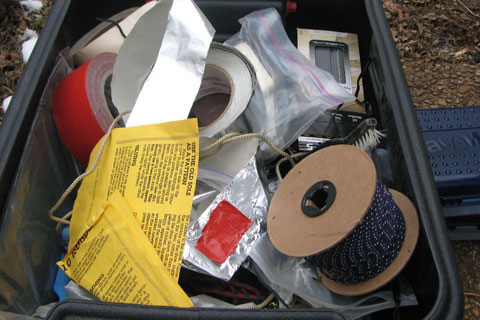| 325 | Hiking Skills - The Ten Essentials - Repair Kit | 2010-12-27 |

While climbing Capitol Peak a couple of years ago, we camped at Capitol Lake. During the night, a bear stepped on our small tent and broke the only pole. We climbed out of the tent, scared the bear away, and by headlamps made a quick fix of the pole. After re-setting the tent we tried to sleep but had little success as we kept an ear tuned to the bear's return. The tent repair, however, was a success. After that mini-adventure we still needed the tent for a few more nights. Our middle of the night repairs held until we were able to replace the pole.
In the garage at home we have a crate full of repair gear. There are various glues, tapes, threads, needles, zippers, etc. With our supplies that we have collected through the years, we are able to repair most items. The problem is when we are in the backcountry, the garage is not nearby. All the repairs, fixes, and modifications have to be made with our limited repair gear packed specifically for that trip. Exactly what we bring on each trip is somewhere between a pocket knife and the whole crate of repair gear. We try to modify the kit for each trip, depending on what gear we will be bringing and how critical the gear is to our trip goals.
Contents of our basic repair kit:
- Knife - The knife needs to be able to do many tasks. It is generally the only repair tool carried, so it had better be a jack of all trades, yet still light enough so as not to be tempted to leave behind.
- Tape - Duct tape is normally considered the standard. It repairs most things.
- Glue - We don't leave home without a small tube of Seam Grip. The glue repairs most fabric tears in our gear and clothing.
- Cord - Small diameter cord for shoe lace replacements, tent guys, rigging a food bag, etc.
Advanced kit:
- Small sewing kit - Something to help you hand stitch those tears.
- Buckle - Spare one that matches those on your pack.
- Spare parts - for your stove, headlamp, crampons, air mattress, etc.
- All purpose tool - A multi-tool - most have pliers, screwdrivers, etc.
And a few suggestions...
- Learn how to repair your gear at home.
- Your repair kit should match the gear you are carrying. For example, if you are using the lightweight silicone fabric for your tent, bag or clothing, you might also need the special Sil-net glue. Nothing else sticks to the slick fabric.
- Divide the repair kit into personal gear and group gear. Keep it light and essential.
- A couple of manufacturers make repair kits. I have never used one, but they seem to be well stocked.
- If you are carrying a first aid kit (and you should - after all it is an essential), then you have tape in the kit. Duct tape could also be used for the first aid tape, or the athletic tape could be used to help with repairs. There is no use in duplicating the tapes.
- Play with your gear at home. Get to know how each piece works. The knowledge you acquire will help when you need to make an emergency repair.
Happy repair kit trails.
Links to Essentials
